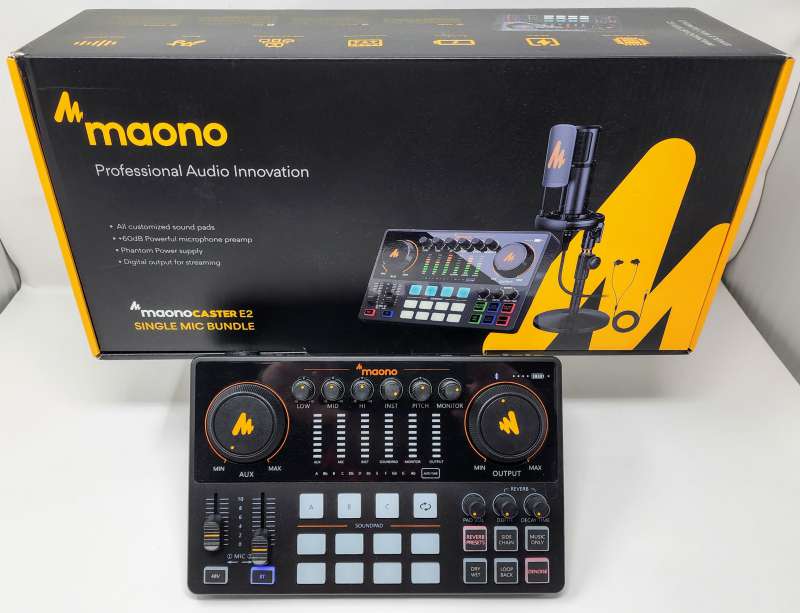
REVIEW: Like everyone else these days, you are likely preparing for your mandatory service as a podcaster or content creator. If so, you are trying to find the right entry-level mixing board and mic that will let you focus on your content and not the tedious mechanics of producing said content. Today we’ll help you jump into the battle by reviewing the Maonocaster E2A mic and board bundle. Does it have what you need to produce the next People’s Choice Podcast award-winning show? Let’s find out…
What is it?
The MAONOCASTER E2A Portable All-In-One Podcast Production Studio review – Budget podcasting on the go! is a single box solution that contains everything (at a basic level) to get a podcast off the ground (ideas and content sold separately). As the Maonocaster is also battery-powered, it is well suited to become a travel mixer, giving you more freedom to create your content anywhere. Essentially, you provide the recording medium (PC, tablet, etc.) and the E2A brings everything else you’ll need.
What’s in the box?
- The Maonocaster E2 portable mixing board
- One Maonocaster PM320 XLR microphone with weighted stand and shock mount
- An XLR cable to connect the mic to the mixer
- 2 audio interface cables (both 3.5mm jacks)
- A USB-A to C cable to charge the battery and/or connect to a computer
- Wired ear buds to use as a monitor when recording
Design and Function
The Maonocaster E2 mixing board looks pretty much like any other beginner’s mixing board out there:

Starting at the top left of the board you have a large knob that controls the sound level of the auxiliary port, usually where you would connect background music or connect via Bluetooth with a secondary audio source (say, for example, the subject of an interview). Next, there are 3 knobs that control the mic’s pitch and three more to control the pitch for any instrument connected to the instrument port on the back side. This is followed by the large output gain control which raises or lowers the mixed output to the recording device. Going down, there are 3 knobs to control the reverb effects and 6 buttons to control additional audio effects such as denoise which reduces background noise. To the left is the bank of custom audio effect buttons – here you can add your own sounds like a rim shot, applause or a laugh track (more on this shortly). Again, to the left are the volume sliders for the mics (left for the XLR-connected mic and right for any analog mic connected to a 3.5mm port on the back). Below that is the 48v phantom power switch for the XLR mic (in case your mic – like the PM320 that comes in this bundle – needs power to operate) and the Bluetooth connection button that allows the mixer to use your phone or another device as an input.

On the front of the board are 2 monitor jacks. You can use the included earbuds here, but I would seriously recommend getting a much better open back headphone like the OneOdio Monitor 80 we reviewed here.

The back side of the Maonocaster E2A is where all the connections happen. Starting on the left, there is an XLR plug and a switch used to determine the type of mic connected via that port (condenser or dynamic). Next to the XLR connection is a 1/4 inch jack for output from a musical instrument like a guitar, although pretty much anything can be used here providing it is self-powered. Next is a 3.5mm analog mic input, an auxiliary sound input, a connector for a monitor speaker, two live outputs (to a sound system, recorders, or whatever you like). Finishing up on the ports, there is a USB-C out to a computer or tablet and an additional USB-C port to charge the battery, power the mixer, etc. Finally, there is a power on/off button and a board light button to turn the lights on the board on or off.
While we are on the subject of the battery (thank you for asking), it takes about 3.5 hours to fully charge the battery. Depending on whether your mic of choice requires 48v phantom power, you can expect north of 1.5 hours battery time on a full charge with power and closer to 3 without that power. Although the battery is nice to have, running this on an independent power source (as in not connected to your computer’s USB port to power it) is the way to go.
And also speaking of plugging this in, there are no special drivers or software needed. On both Windows and macOS the Maonocaster E2 is recognized as a mic and every app that can use a mic will see it as such. For example, I used this with Tech Smith’s Camtasia as well as Audacity without having to do anything special other than hitting the record button.
Let’s talk about the mic – the PM320 XLR mic that comes in the bundle.
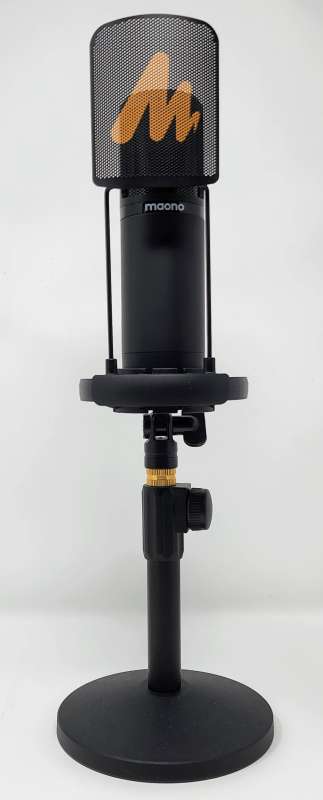
The mic is a cardioid polar pattern condenser mic. That may be the most jargon-laden sentence I have ever written. Simply put, the mic picks up the sound immediately in front of and behind itself, but not from the sides. This makes it an excellent interview mic that can be set in front of the interview and subject. There is a small gotcha here, though: the PM320 is a sensitive mic, and during my review, I found it would occasionally pick up sound from another room in the house because the back side of the mic was pointed towards my open office door. So, like any other mic, placement is important and it is good to know that before you start to record. Denoise can help, but nothing works better than a closed door.
The mic comes with a metal pop filter that snaps into the shock mount. It works, but it feels a little loose when mounted. Since the bundle does not come with a second filter, if you intend on using this as an interview mic, you will want to get another to avoid runaway plosives.
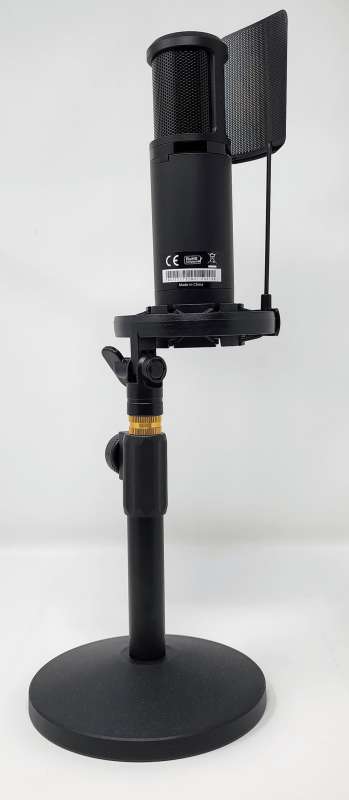
A side view of the mic and desk stand. The mic is sitting in the shock mount which has a 180 degree adjustable tilt joint just before the mount threads. There is also a knob on the base that gives up to an extra 6 inches of height if needed.
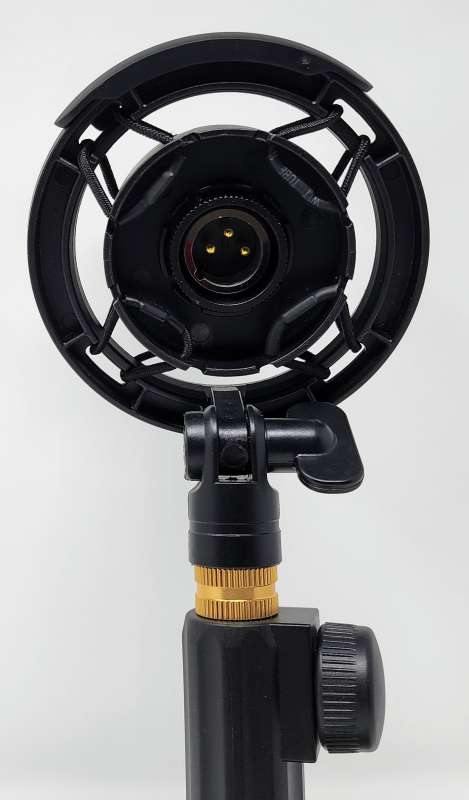
The bottom view – here you can see the XLR connector, the shock mount, and adjustment screws.
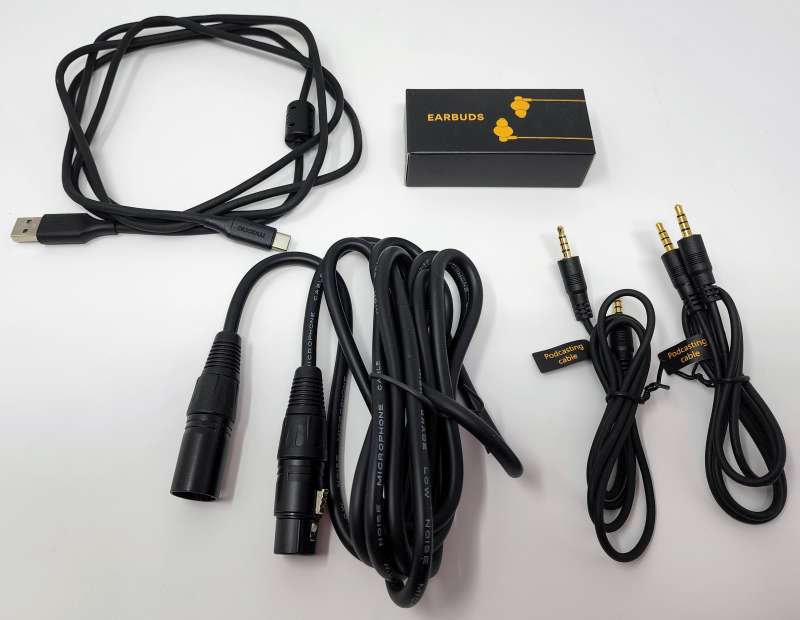
And all the other stuff that comes in the box.
How does it work?
After finding a spot for the MAONOCASTER E2A Portable All-In-One Podcast Production Studio review – Budget podcasting on the go! on my cluttered desk, I plugged everything in and prepared to record narration for a training video I have been working on. While I don’t need sound effects in my day-to-day, I decided to assign some regardless to see how well the process works. As the E2 does not accept digital input via the USB-C computer connection, any sound cue you want to record has to come in via a recording from an analog source (the aux in, a mic, Bluetooth, etc.). Recording is pretty easy and each button can store about 20 seconds with the A, B and C buttons expanding that to almost a minute. To record, press and hold the button you want to use for 3 seconds. The light will slowly blink, so release the button for the recording to start. Short press the button when you are done to stop recording, or wait 20 seconds for the recording to run out of space. From then on, a short press of the button will play the sound. Although I would love to be able to directly add a sound file to a button, this works just fine as long as you have the sound cued up and ready to go to prevent any sort of awkward gap.
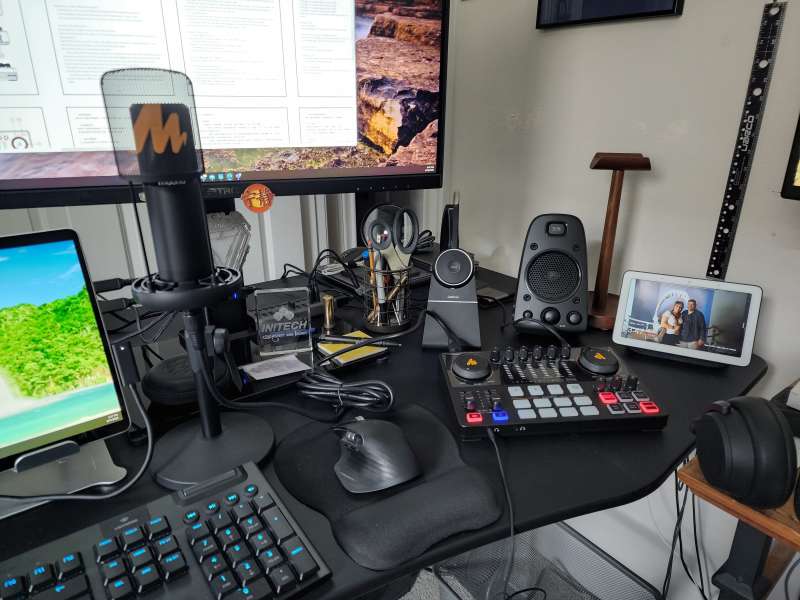
Told you my desk was cluttered.
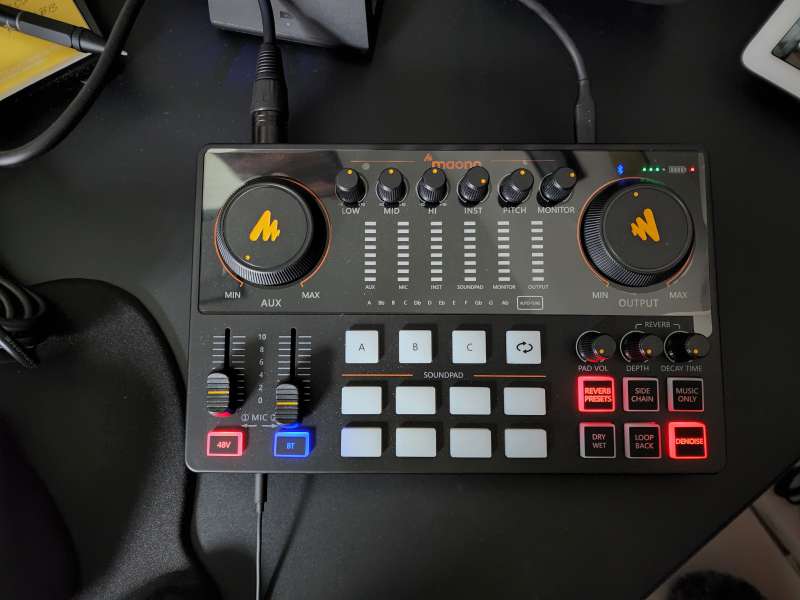
Although from the computer’s perspective the E2 is just another mic, I find having this in between the recording app and the mic is a game changer. I have far more control over the output now than I did previously, which for me means less time in post cleaning up audio. The board performs much better than you would think a mixer in this price range would, with the 48v power the proverbial icing on the cake.
The PM320 mic, though, is only adequate. I had to resort to a fair amount of pitch adjustment to get what I thought was a clear audio track. That might be me – I often think that I have a voice well suited for silent films, but side by side with other mics I own I found the PM320 wanting. For instance, my Blue Yeti is perfect out of the box – but since the E2 does not have a USB mic port, I can’t use that. A while back I reviewed the Samson Q9U mic (read that here) and plugging that into the E2 I think I have found the perfect recording setup for me. No extra processing work is needed and the addition of the E2 (as opposed to the Elgato XLR connector I have been using) makes for some of the best audio I have produced.
Is the MAONOCASTER E2A Portable All-In-One Podcast Production Studio review – Budget podcasting on the go! perfect? No. The buttons have a little spongy feel to them when pressed and the volume sliders are a bit wobbly. But these are pretty minor gripes when compared with the stellar output and the ease of use. Maono put the money there, and it shows.
What I like
- The number of input sources available
- The clear, crisp output
- How easy it is to learn to use this board
What I’d change
- Add a USB input port to allow direct transfer of audio files to the sound effect buttons
- Add a wall charger to the box to charge the battery/power the board
Final Thoughts
A good mixing board is hard to find. The truly great ones have a price tag that looks like the annual budget of a Caribbean nation, and the budget boards sound like their price tag (cheap). The MAONOCASTER E2A Portable All-In-One Podcast Production Studio review – Budget podcasting on the go! is the happy medium – a budget setup that sounds like a more expensive board. With everyone and their second cousin entering the content producing fray, anything you can do to set yourself ahead of the pack is a necessity, not a nice to have. This bundle brings great sound and ease of use, which in turn means you can focus on your content and not the mechanics of producing it. And at $170 for the bundle, it is unlikely that you’ll find a better setup out there for the money.
Price: $169.99 on Amazon, $179.99 at Maono
Where to buy: Amazon or directly from Maono
Source: The sample for this review was provided by Maono


